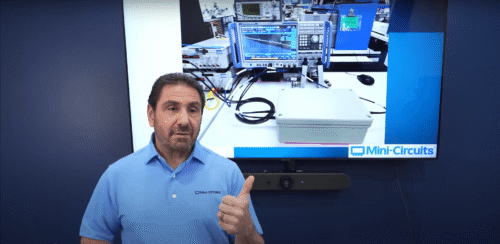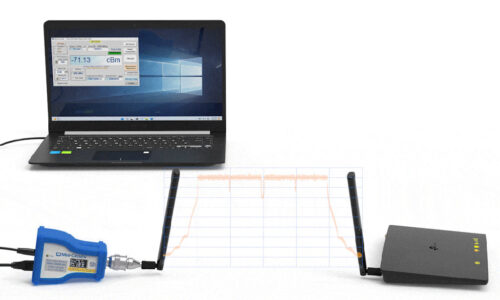High-Order Switch Matrices Facilitate Network Infrastructure Testing
Chi Man Shum, Vice President, Test and Measurement, Mini-Circuits
Testing cellular network infrastructure often requires measurement and data collection from dozens – even hundreds – of base stations (BTS) within a test environment. The volume and complexity of signal traffic in these multi-device, multi-user test systems necessitates commensurate capability for routing signals between base stations and test stations. By partnering with customers to lower costs and improve efficiency in high-volume test systems, Mini-Circuits has developed a line of high-order switch matrices supporting a wide variety of switching configurations and control methods. This article will present a case study of a 20 x 6 non-blocking, full access switch matrix used to facilitate signal routing in a cellular network test system with extensions for other applications.
Case Study: A High Order Switching System for Cellular Network Testing
A cellular network operator was building a test setup to validate new BTS equipment on their network. The test system needed to evaluate each channel of new BTS nodes to verify they were meeting specifications; it needed to confirm that new equipment worked alongside existing, heterogeneous equipment without adverse interactions; and it needed to allow validation of supported handsets with the new BTS equipment.
For this functionality, the customer required a signal routing system to connect 6 independent test stations to any or all of 20 base station (BTS) channels. The setup needed to allow multiple users to connect to the same BTS if necessary, but also required a control mechanism to limit which test stations could access which BTS. To satisfy these requirements, Mini-Circuits developed the ZT-20X6NB, a 20 x 6 non-blocking full access switch matrix. This bi-directional switch matrix covers the key worldwide telecommunications bands from 600 MHz to 6 GHz and can be programed to connect ports B1 – B6 (shown in Figure 1) to any combination of ports A1 – A20, such that multiple input ports may be routed to the same output port simultaneously. Because of its flexibility, this non-blocking configuration is ideal for multi-user, multi-device test systems of the kind this customer was building.

The system is designed into in a compact, 5U height, 10-inch rack-mountable chassis with all 26 RF connections (N-type) easily accessible on the front panel (figure 2). It includes both USB and Ethernet control interfaces along with a built-in touch screen giving users a versatile range of control options. Software support is provided through Mini-Circuits’ user-friendly GUI application for remote control over a network or via USB connection. ActiveX and .NET API objects for Windows environments and HTTP / Telnet support ensure compatibility with most common programming environments.

User Permission Control
In order to allow multiple, independent tests to be conducted in parallel while preventing one user from inadvertently disrupting another’s test, the GUI software features a user profile management interface through which an Admin can create and manage user profiles to control which users have access to which switch paths. Permission settings for different user access configurations can be saved as permission files and loaded to the GUI as needed in the future, minimizing setup time.

Cloud Sandbox Capability
In addition to USB, Ethernet and touch-screen control interfaces, the ZT-20X6NB system also incorporates “Cloud Sandbox” software that allows a customer to replicate a particular network or production environment. This virtual replica environment, called a sandbox, can be used for development, testing, demos, training and support. It allows the user to create a virtual, on-demand lab environment that is accessible from within a self-serviced cloud.
This cloud sandbox capability allows complex network infrastructure and automated test systems to be modelled and developed offline, in a virtual environment which consists of complex entities such as virtual, physical and network elements. Each of these environments is made up of various “shells,” which are the building blocks that model infrastructure and applications. These shells are similar to device drivers that control a specific device. Mini-Circuits has created a shell of the ZT-20X6NB for this purpose. Using this shell, the user can include the ZT-20X6NB into their virtual lab environment within the cloud sandbox.
Combined with a powerful orchestration script to author and direct a workflow, a complete environment replica with specific triggers can be created. Later, the sandbox environment can be deployed via portals and API’s to be accessed by developers within and outside the company, thus enabling easier collaboration, shorter development times and lower overall costs.

The ZT-20X6NB is just one example of Mini-Circuits’ capabilities to develop equipment to multiplex application-specific tests systems across multiple DUTs and multiple test stations in a wide variety of configurations. This system was developed for a unique set of requirements for the network test application described here, but the same capabilities can be readily extended to many other applications.
Extension 1: Cascadability
Depending on the number of test channels needed in a particular test setup, some users may require the flexibility to add multiple switch matrices into their system. To support this need, Mini-Circuits test systems have been developed with SPI interfaces, allowing a user to cascade multiple units in daisy chain configuration. All software commands are issued to the Master unit (the first unit in the chain), which controls all subsequent Slave units in the chain. The GUI software is extensible to support multiple cascaded units comprising hundreds of test channels, allowing the user to scale his or her setup while managing all switch paths of all units through a single, simple control interface.

Extension 2: High-Speed Solid State Switching
Consumer demand for ever higher data capacity is driving extensive efforts by network operators to accelerate research and development toward deployment of next generation wireless technologies like Massive MIMO and 5G. Because of the dense deployment model for these technologies, test systems need to collect very high volumes of data from many different base stations at once. Routing test signals in these systems requires extremely fast switching.
To respond to the growing need for this capability, Mini-Circuits developed the ZTS-series of solid state switching systems. These systems incorporate solid state switches with very high isolation and switching speed in the order of 1 microsecond. These switches can be readily integrated into a system similar to the ZT-20X6NB, but with the advantages of solid state switch componentry for applications in which these features are needed.
Conclusion
The diversity of real-world test applications makes it virtually impossible to realize anything like a standardized solution, so Mini-Circuits has built our business in this area around principles of technical capability, flexibility, and speed. The specifications for many test solutions are often being defined concurrently with the design process, forcing us to be agile in the design and fabrication of a wide range of unique, user-defined solutions in a very short period of time. The turnaround time on these test systems directly affects customers’ time to market, so they’re depending on us to deliver a tailored solution, fast.
Mini-Circuits has developed a range of switch matrices, signal distribution and level control systems, some simple and others highly complex, that are used to interface between DUTs and a variety of signal generation and analysis equipment. We’ve capitalized on a building-block approach to developing custom equipment for each customer’s unique needs. Our wealth and variety of components and subassemblies in stock allows us to create integrated assemblies for a wide range of custom specifications with exceptionally fast turnaround times.
The ZT-20X6NB is just one example of a solution we’ve developed for increasingly complex network infrastructure testing applications. As wireless standards and infrastructure continue to evolve, we expect the number and diversity of applications to expand as well, and we’re looking forward to supporting our customers with more innovative solutions through this transition.











